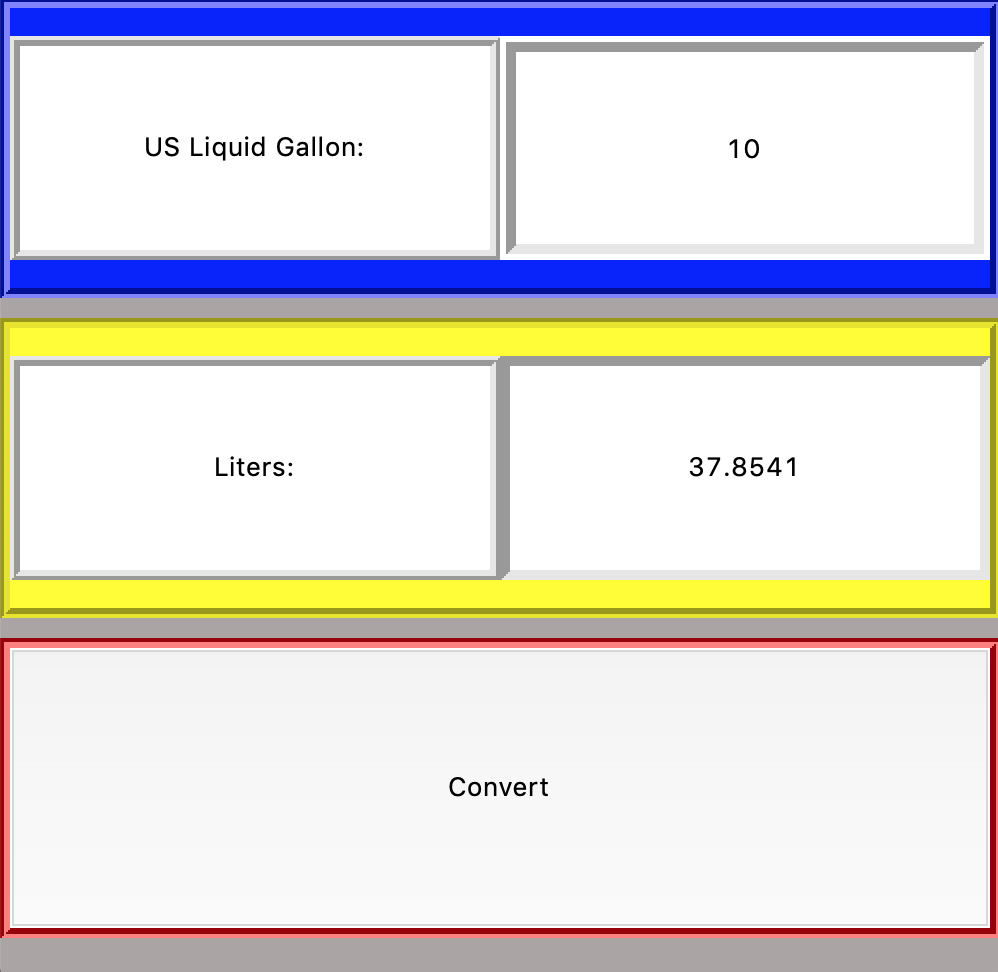#!/usr/bint/python
import tkinter as tk
class myGUI(object):
def __init__(self):
self.main_window = tk.Tk() # create root window
self.main_window.pack_propagate(0)
self.main_window.geometry("500x500")
self.main_window.configure(bg = "#AAA5A4")
self.frame1 = tk.Frame(self.main_window, bg = "blue", bd = 5, relief = "groove") # create frame 1
self.frame2 = tk.Frame(self.main_window, bg = "yellow", bd = 5, relief = "groove") # create frame 2
# add components into frame1
self.label1 = tk.Label(self.frame1, text = "US Liquid Gallon:", bd = 5, relief = "ridge")
v = tk.StringVar(self.frame1, value='10')
self.entry = tk.Entry(self.frame1, textvariable = v, bd = 5, relief = "sunken", justify = "center")
self.label1.place(relx = 0, rely = 0.1, relheight = 0.8, relwidth = 0.5, anchor = "nw")
self.entry.place(relx = 0.5, rely = 0.1, relheight = 0.8, relwidth = 0.5, anchor = "nw")
self.frame1.place(relx = 0, rely = 0.02, anchor="nw", relheight = 0.3, relwidth = 1)
# add components into frame2
self.label2 = tk.Label(self.frame2, text = "Liters:", bd = 5, relief = "ridge")
self.label3 = tk.Label(self.frame2, text = "37.8541", bd = 5, relief = "sunken")
self.label2.place(relx = 0, rely = 0.1, relheight = 0.8, relwidth = 0.5, anchor = "nw")
self.label3.place(relx = 0.5, rely = 0.1, relheight = 0.8, relwidth = 0.5, anchor = "nw")
self.frame2.place(relx = 0, rely = 0.34, anchor = "nw", relheight = 0.3, relwidth = 1)
# add components into frame3
self.frame3 = tk.Frame(self.main_window, bg = "red", bd = 5, relief = "groove")
self.button = tk.Button(self.frame3, text = "Convert", bd = 20, relief = "raised", bg = "green", command =self.convert)
self.button.bind("<Button-1>", self.mouseclick)
self.button.bind("<ButtonRelease-1>", self.mouserelease)
self.button.pack(side = "left", expand = True, fill = "both")
self.frame3.place(relx = 0, rely = 0.66, anchor = "nw", relheight = 0.3, relwidth = 1)
tk.mainloop()
def convert(self):
value = self.entry.get()
self.label3.config(text = str(float(value)*3.78541))
def mouseclick(self, event):
self.frame3.config(bg = "#395497", relief = "sunken")
self.button.config(activebackground="blue") # button color is supported in Mac
def mouserelease(self, event):
self.frame3.config(bg = "red", relief = "groove")
def main():
gui = myGUI()
if __name__ == '__main__':
main()
import Tkinter as tk
class myGUI(object):
def __init__(self):
self.window = tk.Tk()
self.window.geometry("200x100")
self.window.resizable(0, 0)
self.frame = tk.LabelFrame(self.window, text = "Scrolling", bd = 2, relief = "sunken")
self.frame.place(x = 10, y = 10, height = 80, width = 180, anchor = "nw")
self.scrollbar = tk.Scrollbar(self.frame)
self.scrollbar.place(x = 160, y = 0, height = 80, width = 10, anchor = "nw")
self.listbox = tk.Listbox(self.frame, bg = "blue", bd= 0, yscrollcommand=self.scrollbar.set)
self.listbox.place(x = 0, y = 0, height = 80, width = 160, anchor = "nw")
self.scrollbar.config(command=self.listbox.yview)
for i in range(100):
self.listbox.insert(i, i)
tk.mainloop()
def main():
gui = myGUI()
if __name__ == '__main__':
main()

